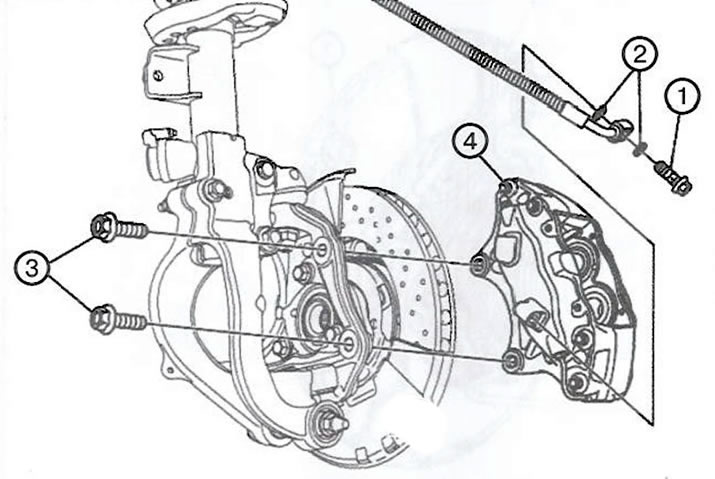J60, J61
1. Raise and secure the vehicle.
2. Remove the front wheel from the vehicle.
Attention. Do not press the brake pedal with the caliper removed from the brake disc to prevent damage to the elements of the brake system.
3. Unscrew the hollow bolt (1) brake hose fittings.
Note. Tightening torque: 40 Nm.

4. Remove two spacers (2) brake hose.
Note. Use only new gaskets every time you install a brake hose (2).
5. Disconnect the front brake hose (3). Plug the holes to prevent leakage of brake fluid and dirt from entering the brake system.
6. Remove two screws (4) brake caliper guide pins. Check the brake caliper guide pins for smooth movement and the condition of the anthers. Moving the guide pins in the holes of the caliper bracket in-out, without disconnecting from the anthers, check the following:
- Limiting the movement of the guide pins.
- Looseness in the caliper bracket.
- Jamming or sticking of guide pins.
- Cracking or damage to anthers.
If any of the listed defects are found, replace the guide pins and / or anthers.
Note. Tightening torque: 27 Nm.
7. Remove the front brake caliper (5).
8. Installation is made in an order, the return to removal.
Attention. When bleeding the brake system when replacing the brake caliper, the pressure in the system may be higher than during normal bleeding. Make sure the bleed hose is securely attached to the bleed fitting before opening the bleed fitting. If the fitting is not properly secured, the hose may break off when the fitting is opened, which may result in splashing of brake fluid.
Bleeding the brake system to remove air from it must be carried out after each depressurization of the brake system for repair. Failure to do so may result in failure of the brake system, resulting in a life-threatening traffic accident.
J62
1. Check the brake fluid level in the expansion tank of the main brake cylinder:
- If the brake fluid level is in the middle between the lower and upper marks, no additional operations with the brake fluid are required.
- If the brake fluid level is above the middle between the lower and upper marks, it is necessary to remove part of the brake fluid with a syringe before starting work.
2. Raise and secure the car.
3. Remove the front wheel from the vehicle.
4. Unscrew the hollow bolt (1) fastening the brake hose to the caliper, and remove the brake hose.
Note. Tightening torque: 40 Nm.

5. Remove two copper pads (2) brake hose. Plug the holes in the brake hose and caliper to prevent leakage of brake fluid and dirt from entering the system.
Note. When installing, use only new brake hose gaskets (2).
6. Remove two screws (3) brake caliper guide pins and remove the brake caliper from the mounting bracket. Check the brake caliper guide pins for smooth movement and the condition of the anthers. Moving the guide pins in the holes of the caliper bracket in-out, without disconnecting from the anthers, check the following:
- Limiting the movement of the guide pins.
- Looseness in the caliper bracket.
- Jamming or sticking of guide pins.
- Cracking or damage to anthers.
If any of the listed defects are found, replace the guide pins and / or anthers.
Note. Tightening torque: 32 Nm.
7. Remove the front brake caliper (5).
8. Installation is made in an order, the return to removal.
Attention.
- When bleeding the brake system when replacing the brake caliper, the pressure in the system may be higher than during normal bleeding. Make sure the bleed hose is securely attached to the bleed fitting before opening the bleed fitting. If the fitting is not properly secured, the hose may break off when the fitting is opened, which may result in splashing of brake fluid.
- Bleeding the brake system to remove air from it must be carried out after each depressurization of the brake system for repair. Failure to do so may result in failure of the brake system, resulting in a life-threatening traffic accident.
J64
1. Raise and secure the vehicle.
2. Remove the front wheel from the vehicle.
3. Remove the brake pads.
4. Unscrew the hollow bolt (1) fastening the brake hose to the caliper. Plug the holes in the brake hose and caliper to prevent leakage of brake fluid and dirt from entering the system.
Attention. Do not press the brake pedal with the caliper removed from the brake disc to prevent damage to the elements of the brake system.
Note. Hollow Bolt Torque (1): 40 Nm.

Attention. Do not press the brake pedal with the caliper removed from the brake disc to prevent damage to the elements of the brake system.
Note. Hollow Bolt Torque (1): 40 Nm.

Visitor comments